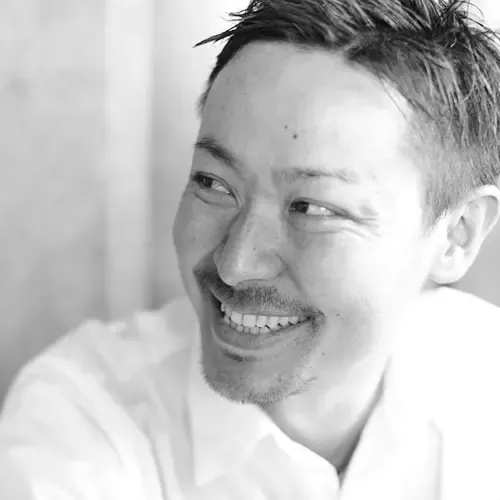神山サテライトオフィス勤務の栗原です。
早いもので、去年の6月末から神山に住み始め、あれからあっという間に1年が過ぎ、2回目の夏も勢い良く過ぎ去ろうとしています。
前回は「仕事と暮らし・神山」にて神山勤務のメンバー紹介を兼ねた記事を書きましたが、今回は私自身、神山だからできた生活面での変化についての話を書いていこうと思います。
畑。開墾しました。
見出しの通り、今現在、家の前の6〜7畳ほどの庭の荒れた土地を開墾して畑(家庭菜園)を始めています。

左が開墾前。雑草が伸び放題の庭。右が現在の様子。中央の生い茂っているのが野菜です。
畑を始めた当時のことを考えると、東京では経験できない神山だからできる新しいチャレンジを探していたのかと思います。
関わり合いを持たせてもらっている人たちの雰囲気なのか、神山の流れなのか…。何か心の根底に、東京ではなく神山らしさ、地方の山間部での暮らしらしさ的なものを…。
その結果、行き着いた先が畑だったのではないかと思います。
なぜ、畑なのかというと、家の前に畑ができる土地があったのが、一番の理由。
そして、ちょうどその頃、プロデュース部の真鍋が携わっている Food Hub Project が「地産地食」というキーワードを掲げ、かま屋オープンに向け立ち上げ準備中だったということもあり、食に対する会話が周りで行き交うことで少なからず「食」が身近な存在になったのではと思います。
( Food Hub Project の活動内容は割愛します。詳しくはこちら)
今まで、食に対して考えるきっかけはほぼなく、好きなものを好きな時に食し、スーパーに行っても野菜はほとんど買うこともなく、野菜を買うとしても、出荷元が異なる同じ野菜が複数並ぶなかで、何を決めて選ぶかと言うと、決まって安さで購入を決めているような感じでした。
今は、少なからず自分が口にする物がどんなものかは考えるようにはなったかなと思います。
食に対してこだわりを持っているような書き方をしましたが、産地、無農薬野菜でなければいけないなどのこだわりはまったくなく、無農薬野菜とそうでない野菜を並べられても、違いには気付かないと思います…。
選択肢として、価格で判断するということは、あまり変わってはいませんが、それをどこで買うかは考えるようになったと思います。
例えば、スーパーで安い野菜を買うのではなく、道の駅などで旬の野菜を安い価格で買うといったことを考えるようになったかなと。
プラス、「買う」のではなく「育てる」といった選択肢も神山にきてから増えました。
畑ではこんなものを育てています。
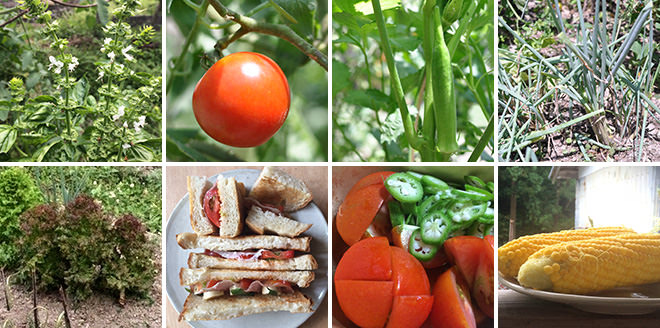
畑の野菜達。サンドウィッチの写真は自家製ミニトマト、バジルとチーズ、ハムを挟んだもの
通称「栗原 ふぁあむ」の小さい畑では、いままでに色々な種類の野菜を育ててきました。
正確にいうと、種を蒔いてみた。という表現の方が適切かもしれませんが。
農作物は土作りからと言われていますが、まずは種をまき、育てること、そして何より収穫を楽しむことにしています。
野菜づくりには土作りが99%大事と言われていますが、酸性の土やアルカリ質の土など、化学の世界となりとても深い分野となるので、手は出せませんでした。
やったこととしては、「天地返し」といって土深くの栄養分や微生物が多くある土と浅い部分にある土を引っくり返して混ぜることをやったり(手作業なので地味に大変)、気が向いた時にコンポストから腐葉土を持ってきては蒔いたりと、できる範囲で土づくりをしていました。
そんな畑では、こののような野菜(果物)を育てています。
常にあると便利。毎日食べれるやさいたち
- ミニトマト
- 大葉
- オクラ
- ネギ
- リーフレタス
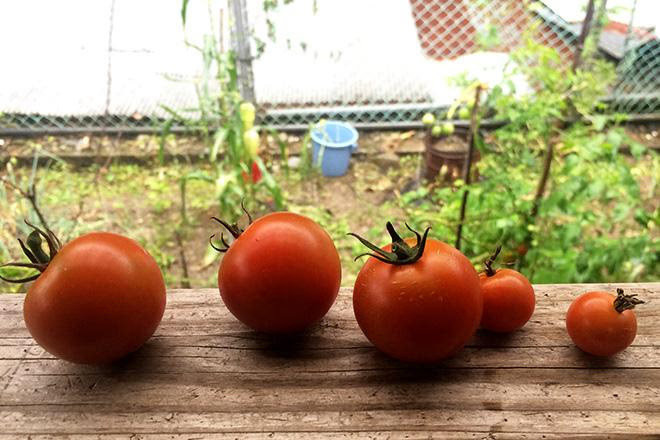
8月は一番の収穫高でしたが、最近は寒くなったのか取れる量が少なくなりました。
「ミニトマト」は苗を1つ購入して、それを植えて育てています。育てる段階で定期的に実に栄養が行き渡るように長くなった枝を間引く(切る)のですが間引いた枝は捨てずに、畑に植えれば、いずれ根が貼ります。
繁殖性が高いのか、切っては植えてを繰り返していると「栗原 ふぁあむ」一大勢力となり、畑の大部分をミニトマトが占領しています。
おかげで、多くの実を付けてくれ、毎日食べごろの赤い実を5〜6個収穫できるので、洗ってただ切るだけで一品サラダとしても、多少調理をすることで、食卓が彩り豊かになります。
「大葉」は全家庭で育てるべきと思うぐらいの植えてよかった野菜のひとつです。徳島県のご当地そうめんである、半田そうめん(一般的なそうめんに比べやや太くコシがある)に添えて食べたり、豚肉に巻いて食べるなりして、あまり使いどころがないように見えて、どんな料理にも使えています。
このように常時収穫できる野菜があると、とても重宝しています。夜、家に帰ってきてすることとしては、ヘッドライトを装着し夕飯に食べる野菜を収穫するのが日課となっています。
その他の野菜たち
- とうもろこし
- スイカ
- なす
- ハーブ類
「とうもろこし」はこの夏ぜひ育ててみたかった野菜です。
他の野菜に比べ、ぐんぐん著しい成長をみせ、自分の背丈ぐらいに育ったのですが、なかなか実がならない…。
いろいろな人に聞いてみたり、調べてみるとどうやら受粉をさせる必要があるとか。本来は蜂が受粉させてくれたり、自然と花粉が落ちることで受粉に至るとのことでしたが、意を決して人工授粉を敢行しました。(ただ、穂?を揺らし黄色い花粉を雌しべに落としました。)
しばらくしたら、実がなり、けして実の付きが良いとは言えませんでしたが、とてもとても甘いとうもろこしとなりました。
ほぼ、その場で収穫して皮を剥き生で食べてしまい、食卓で食べることがほぼなかったですが。

初代スイカの実がなった時の写真。直径3〜4cm。
「スイカ」は近所のおかーさんが、代わりに育ててと苗を持ってきてくれたのを植えています。
植えてすぐに実がなり、すくすくとシマシマ模様のスイカが育っていたのですが、東京へ出張で出かけて帰ってきてスイカの様子を見に行ったら、実がないのです。スイカ泥棒です。
今でも謎ですが、直径20cmぐらいあるスイカを持っていく動物?も大変だったと思います。
それからも、受粉を繰り返しましたがなかなか実がつくことがなく、夏が終わろうとしている最近になって、新しい実がなりました。
全部の野菜についてエピソードを書くと長くなるのでこの辺で。
と締めくくろうとしていますが、小さい畑で数種類の野菜を自分自身で育てみて感じることは、やってみて良かったな、ということ。
実が付いた時は本当に感動します。本当に感動するのです。
数ヶ月、うんともすんとも言わなかった茎から実ができたり、暑くなりだしたら急に成長スピードがあがったり。
毎回、畑を見るたびに、色々な変化・感動があります。ちょっと大げさに聞こえるかもしれませんが、本当なのです…。
自分がいま口にしている野菜は、どういう工程で育てられ、収穫されているかということが少しわかるようになり、野菜を育てる難しさ、大変さを体験することで学びました。本当に農家の方々に感謝です。
一番の収穫は、自分が育てた野菜はとても「おいしい」ということがわかったということです(笑)。
とても、ありがたいおすそ分け
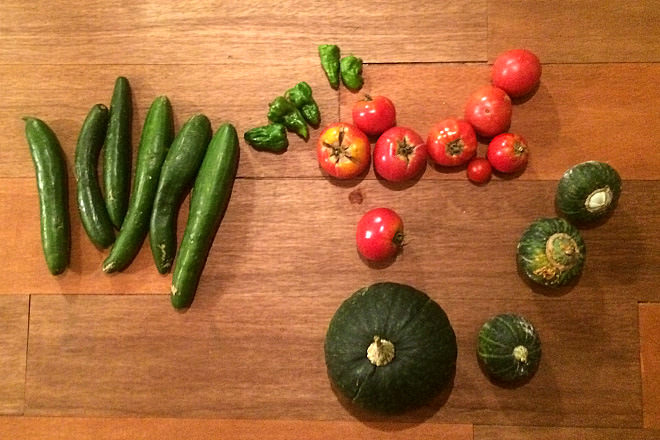
自分で育てるだけでなく、野菜を近所の方が、オフィスに持ってきてくれたり、家まで持ってきてくれたりもします。
とてもありがたいことに、プリプリに大きく育った野菜たち。大きさだけではなく量もはんぱなく多くいただけるのです…。
せっかく頂いたものなので、全て食せるように日々消化していくのですが、やはり人間というものには、残念ながら「飽きる」という性質があります。だんだんと食べる気力がなくなってきてしまうのです。
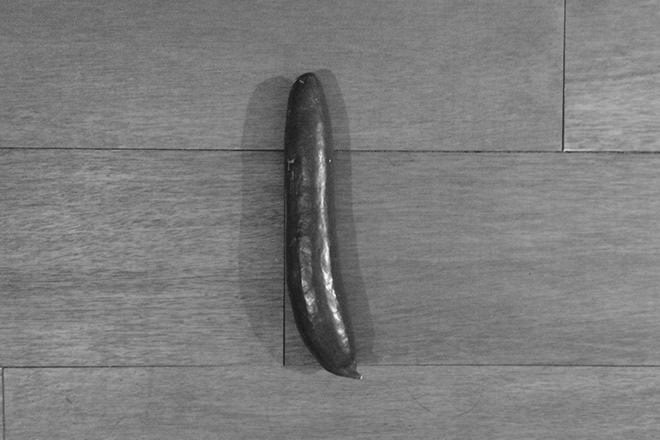
きゅうり。
特に辛いのは、「きゅうり」です。いや、「きゅうり」だけが辛いです。
小学生の時は、好きな野菜は「きゅうり」と答えていたぐらいきゅうりが好きでしたが、今は嫌いです。
去年、大量のきゅうりを至る所からもらい、それを毎日、もろみに付けて食べていたら、飽き、すべて食べきらなければいけない使命感のみで食べきりました。
(レパートリーが少なすぎるのも原因ですね)
そんなトラウマがある中で、今年もきゅうりの季節が訪れました。
去年ほどでもないですが、きゅうりを近所の方から頂いたり、かま屋に食事に行けば、きゅうり料理が出てきたり、実家から荷物が届き、箱をあけたら他の食材にまみれて、きゅうりが入っていたり(これが一番、キツかったです)と、今年もきゅうりの旬をしっかりと感じることができた夏でした。
きゅうりへのトラウマは数年は残り続けるとは思いますが、その他の野菜に関してはとても
おいしく頂いています。
いただく野菜は自家菜園でやっていて無農薬だからか、とても味がしっかりしていて本当においしいです。
ご近所のみなさん、いつもありがとうございます。
野菜の旬。
最近では、神山サテライトオフィスのメンバーと「トマトどうなった?」「芽出た?」とか「アブラムシの被害がひどくて」「とうもろこし食べ来る?」と野菜の話をしたりと、モノサスに入社した時には思ってもみなかった会話を社内メンバーとしています。
いままでは、スーパーに行けば玉ねぎ、きゅうり、キャベツ、レタス、トマトが一年中手に入るのが当たり前となり、「旬」のものを意識して買い物をすることはなかったのです。
今は、神山にいることで、ご近所さんから野菜をもらったり、自分で野菜を育てるようになったりと、嫌でも旬を感じるようになりました。
旬とは、「他の時期よりおいしく食べれる時期のこと」
旬を意識していなくても、おいしいものは確かにおいしいです。
旬なものを知り、食すことで、よりおいしいものに出会える可能性が高くなり、新しい発見があり食の幅が広がった気がします。また、より季節を意識するようになりました。
そんな発見・変化を見つけられる神山での生活を今回は紹介してみました。
夏が終わり、すでに肌寒く、今は秋・冬に向けて、何を育てようか現在、計画中です。また、これからの旬はすだち。収穫を楽しみたいと思います。
ちょうどこの記事を書いている8月末に、スイカを初 収穫しました。
旬からそれていますが、とても身が詰まっていて、味もしっかりとしたスイカができました。
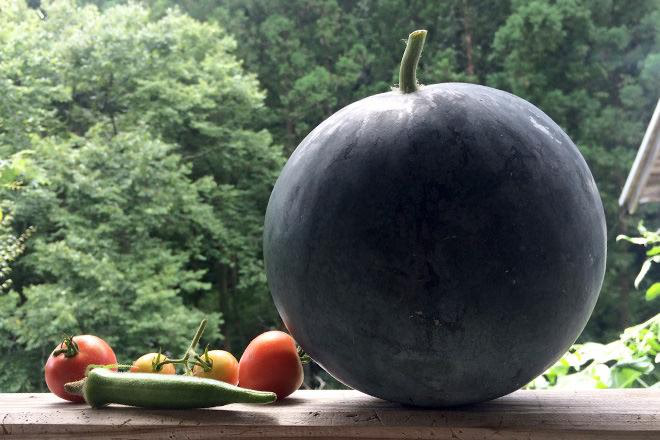
初収穫のスイカ(縦縞模様なし)に常連のミニトマトとオクラを添えて。

